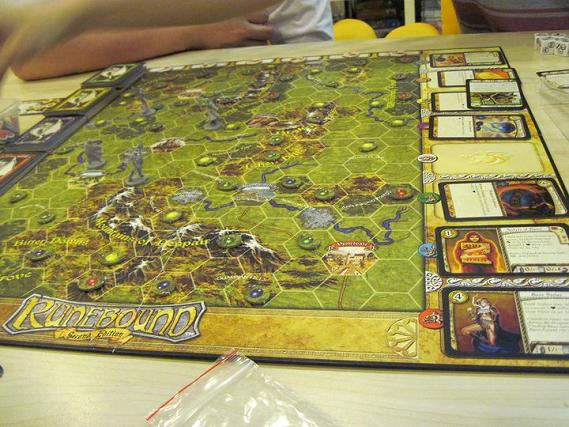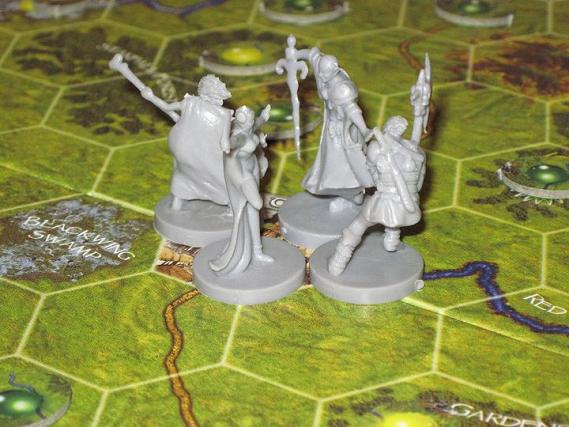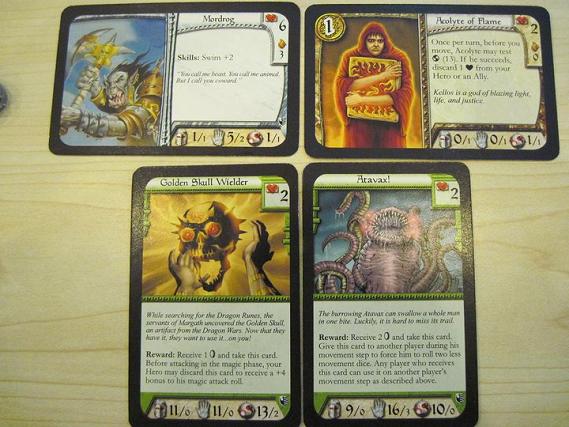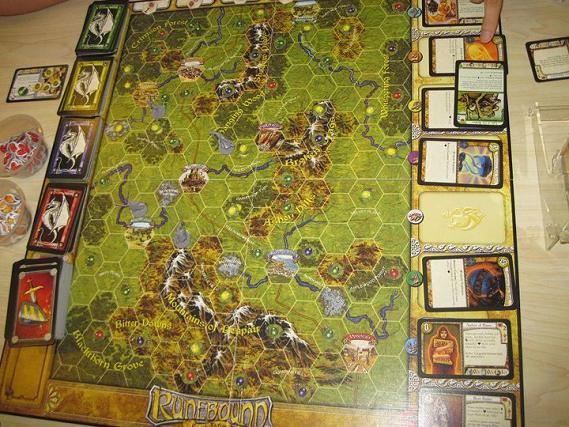
Our Runebound session not too long ago was actually our first official exposure to Ameritrash adventure boardgames, but I’ve read up on them enough to already know what to expect. Apparently, they all share the same central conceit. Each player takes control of a hero and travels across the board to complete quests. This invariably requires lots of fighting. As they become more powerful and gain better items, they move on to harder quests. Eventually someone becomes powerful enough to take on the big bad boss, thereby winning the game.
Since we’ve played Descent, most of the art and even rule conventions used in this game are familiar. The game uses the exact same heroes, down to identical plastic miniatures, which probably helped Fantasy Flight to save on production costs, and many of the same monsters and items appear in both games. Personally, despite all of the effort that they obviously made to get the lore right, it’s to generic for me to care about it much but I think the familiarity does help to get up to speed with this game. It helps to understand what the various tokens represent and remember what the different heroes are good at.
Not that Runebound has especially complex rules. The hex map is littered with colored tokens representing the various quests available. Once a hero has moved to a hex with such a token on it, he can choose to attempt a quest. He does this by drawing a card from the deck matching the token’s color. Naturally, green represents the easiest quests while red represents the hardest ones. Some of these cards represent events that may have an ongoing effect in the game and they go into a special spot on the board to remind everyone that they’re active. The player keeps drawing from the deck until he gets a quest card, which represents a monster that he needs to defeat. If he succeeds, he turns over the quest token and keeps it as an experience token which can be traded in to improve his basic abilities.

Combat is fairly simple as well (though characteristically my wife had a hard time understanding it). You work your way through the ranged, melee and magic phases in order. Heroes have skill ratings in each of these areas and also have damage ratings in at least one of them. Monsters also have ratings for these categories on their cards. Generally, the heroes choose one of these phases to attack in and must only defend in the rest while monsters attack in every area that they have a damage rating for. In each phase, the player rolls a die, adds that value to his skill in that area and tries to beat the appropriate number on the monster’s card. If you win a phase in which you’ve chosen to attack, you do the associated damage to the monster. Otherwise, you just avoid taking damage yourself.
Equipment cards makes you better by providing bonuses to your skills or extra damage. The experience tokens you gather can be spent to further improve your skills or beef up your life total. Allies can also be gained and they have skill ratings just like heroes. You use them to fight for you in one of the three phases of every combat round, typically in the area your own hero is weakest at, but be warned, they have a life total of their own and can be killed. Both allies and equipment are mostly obtained by spending money you earn from completing quests in the towns on the map.
The most complicated part of Runebound are the movement rules. Each hex on the map represents a specific type of terrain. At the beginning of his turn, the player needs to roll the terrain dice and note the results, which are icons representing the various types of terrain. If he’s injured or exhausted, he gets to roll less dice. He then spends these icons to move across the map. So, in order to move along a road, you’d need a road icon. Some terrain types appear less often on the dice, such as mountain peaks, so it can be quite difficult to move across them. It’s a pretty unique mechanic but seems like a needlessly complicated one.

Finally, there’s one last rule to be aware of. As this is a competitive game in which the different heroes rush to be the first to complete three red-level quests, there’s next to no interaction between them for the most part. The exception is that a hero may attack another hero if both of them are in the same hex outside of a town. The winning hero doesn’t get experience but can gain the losing hero’s money or items. This turned out to be very pivotal in our session as we learned the hard way that heroes low on life after completing some quests are very vulnerable to being attacked in this way. Needless to say that losing all of the money you’ve been carefully saving up to buy an expensive item in one stroke is a painful experience for the loser but an extremely rewarding one to the victor.
Frankly, I don’t get the appeal of this game at all, and that’s not just because my hero kept miserably dying. Everything is driven by chance which sours the whole experience for me. The dice-based combat is comparatively mild in this respect and is only to be expected, but then you get even more randomness from the dice-based movement, the drawing of quest cards, which can vary quite a bit in difficulty even if they’re of the same color, and the items deck which aren’t even sorted by quality level as in Descent. At that point, every is so driven by chance that I don’t even care what actually happens any more. What’s even more insulting is that different heroes have different skills which are useful in different situations, but you don’t have any control at all over what type you encounters you run into.
It’s also rather sad that the movement system actually involves more decision making than virtually any other part of the game. Deciding which phase to perform your attack in is trivial and even adding allies to the equation doesn’t make it much harder. Similarly, there is usually only a very small selection of items that you can view in the towns and trying to figure out which one suits you best is easy. Moving across the map however can be quite time consuming and complicated if if you want to make the most of your turn. I’d have preferred a simpler point-based movement that allows heroes to move anywhere, and perhaps give movement bonuses to different heroes depending on the terrain. At the same time, I’d have liked to see more tactical options for combat, including a better system for running away when necessary. Really, the focus should be on the encounters, not on how to navigate a route from point A to point B.

I get that games in this genre face the perennial problem of balancing strategic depth against reasonable playing time and complexity. You could easily make player decisions more meaningful for example by classifying quests according to terrain type so that if you attempt a quest that’s on a riverbank you’re more likely to get something that would require swimming skills. Certain types of monsters would also appear more frequently on certain terrain types, so heroes could try to find monsters that they’re strong against. You could also allow players to trade time for better information on what they’re up against and then decide whether or not to risk attempting a quest. But all this would make what is already an unwieldy game even more bloated.
Anyway, I’m not saying that all such adventure games are a lost cause for me. I’ve heard good things about Magic Realm for example, but I’ve also heard that it’s so complex that the only people who know how to play it correctly are the Avalon Hill employees who made it. But maybe it just could be what tickles my fancy. Still, I can’t help thinking that games like Runebound are a solution looking for a problem. Why struggle so hard to provide a fantasy adventuring experience with a boardgame when traditional role-playing games and video games work perfectly well?
3 Responses to “Runebound”
I have Magic Realm. The 2nd/ 3rd edition rules are las thick as a telephone book. Anyway, i think i can handle combat although huge group combat might be difficult, not so good with native & magic rules ….
You can always try the java program Relamspeak (they don’t teach you the rules but otherwise make learning a less painful experience).
Hopefully one day i can get to play it proper.
As for Runebound, with certain house rules, it’a decent game with the base game. Martin Wallace designed the game, i like the combat system though. Played it safe and it’s boring (only try harder quest when u are truly powerful), push your luck and played like a race game, then it’s better (to force other players to take more risk too).
Perhaps “Prophecy” would be better?
@Han
From what little I know of the rules for Magic Realm, it seems like it addresses all of my quibbles with the genre. Adventurers get encounters based on the terrain that they’re in and have lots of options to deal with encounters other than just combat. The combat system seems fantastic as well, if awfully lethal, and seems to have real depth. I believe that apart from ranged combat, the combat system doesn’t even use any dice at all.
I’d love having a go at reading the rulebook someday and seeing if it really deserves its reputation. (I see one PDF coming in at 122 pages.)
@ Roo
I haven’t heard of “Prophecy” before this. I’ll look into it.
Leave a Reply